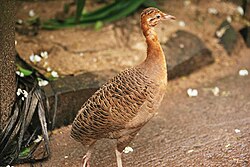Neornithes
| Aves modernas | ||
|---|---|---|
| Rango temporal: Cretácico - Presente | ||
 Tinamú alirrojo (Rhynchotus rufescens) | ||
 Gorrión común (Passer domesticus) | ||
| Taxonomía | ||
| Reino: | Animalia | |
| Filo: | Chordata | |
| Clase: | Aves | |
| Subclase: | Neornithes, 1893 | |
| Clados | ||
Las aves modernas (Neornithes) son un clado que incluye todas las aves actuales, las cuales están representadas por más de diez mil especies.[1] Las aves modernas presentan notables características que las diferencian del resto de vertebrados, siendo tal vez la más notoria que su piel está en su mayoría cubierta de plumas, y que las extremidades anteriores están transformadas en alas. Otras características que distinguen a las aves son la presencia de un pico sin dientes, un corazón con cuatro cámaras, un metabolismo alto y huesos huecos (lo cual favorece el vuelo).
Taxonomía
[editar]Subclase Neornithes:
- Palaeognathae:
- Struthioniformes, avestruces
- Casuariiformes, emúes y casuarios
- Apterygiformes, kiwis
- Rheiformes, ñandúes
- †Aepyornithiformes, pájaros elefantes
- †Dinornithiformes, moas
- Tinamiformes tinamúes
- Neognathae:
- Galloanserae:
- Anseriformes, aves de corral acuáticas
- Galliformes, aves de corral terrestres
- Neoaves:
- Gaviiformes, colimbo
- Bucerotiformes, Cálaos y abubillas
- Podicipediformes, somormujos y zambullidores
- Procellariiformes, albatros y petreles
- Sphenisciformes, pingüinos
- Pelecaniformes, pelícanos
- Suliformes, cormoranes, fragatas, alcatraces, aves serpiente
- Phaethontiformes, rabijuncos
- Ciconiiformes, cigüeñas
- Phoenicopteriformes, flamencos
- Falconiformes, halcones y águilas
- Gruiformes, grullas
- Charadriiformes, gaviotas y chorlitos
- Pteroclidiformes, gangas
- Columbiformes, palomas
- Psittaciformes, loros
- Opisthocomiformes, Hoatzin
- Cuculiformes, cucos y correcaminos
- Strigiformes, búhos
- Caprimulgiformes, chotacabras y nictibios
- Apodiformes, vencejos y colibríes
- Coraciiformes, martín pescador y carracas
- Piciformes, pájaros carpinteros y tucanes
- Trogoniformes, quetzal y trogones
- Coliiformes, pájaros ratón
- Passeriformes, pinzones, cuervos y bienteveos
- Galloanserae:
Sistemática y evolución
[editar]Neornithes se divide en los clados Palaeognathae (tinamúes y ratites) y el muy diverso y heterogéneo grupo Neognathae. Está generalmente aceptado que las aves modernas evolucionarion durante el período Cretácico, produciéndose la divergencia entre Galloanserae (anseriformes y galliformes) y el resto de los neognatos (Neoaves) antes de la extinción masiva del Cretácico-Terciario.[2][3][4] Los hallazgo de las aves fósiles Vegavis y Asteriornis han comprobado la existencia de los Galloanserae en el Cretácico superior. En cambio, todavía no existe un consenso respecto a si la radiación evolutiva de Neoaves ocurrió durante el Cretácico o a comienzos del Cenozoico. El registro fósil de Neoaves está restringido al Cenozoico,[5]mientras que los análisis moleculares varían en sus resultados, desde estimaciones de divergencias totalmente en el Cretácico,[2][3] hasta estimaciones completamente en el Cenozoico,[6] con otros estudios sugiriendo una radiación más o menos coincidente con el límite Cretácico-Terciario.[4][7]
| Neornithes |
| |||||||||||||||||||||||||||||||||||||||||||||||||||
Cladograma basado en Hackett et al. (2008).[8]
Referencias
[editar]- ↑ Peterson, A. P. «Birds of the World -- current valid scientific avian names.» (en inglés). Consultado el 25 de enero de 2010.
- ↑ a b Brown J. et al. (2007) Nuclear DNA does not reconcile 'rocks' and 'clocks' in Neoaves: a comment on Ericson et al.. Biology Letters 3(3):1-3.
- ↑ a b Ericson P. G. P et al. (2006).Diversification of Neoaves: integration of molecular sequence data and fossils. Biology Letters 2(4):543-547.
- ↑ a b Claramunt, S.; Cracraft, J. (2015). «A new time tree reveals Earth history’s imprint on the evolution of modern birds». Science Advances 1 (11). doi:10.1126/sciadv.1501005.
- ↑ Mayr, G. (2014) The origins of crown group birds: molecules and fossils. Palaeontology, 57:231–242. doi: 10.1111/pala.12103.
- ↑ Prum, R. O.; Berv, J. S.; Dornburg, A.; Field, D. J.; Townsend, J. P.; Lemmon, E.; Moriarty Lemmon, Alan R. (2015). «A comprehensive phylogeny of birds (Aves) using targeted next-generation DNA sequencing». Nature 526 (7574): 569-573. doi:10.1038/nature15697.
- ↑ Jarvis, Erich D.; Mirarab, Siavash; Aberer, Andre J.; Li, Bo; Houde, Peter; Li, Cai; Ho, Simon Y. W.; Faircloth, Brant C. et al. (2014). «Whole-genome analyses resolve early branches in the tree of life of modern birds». Science (en inglés) 346 (6215): 1320-1331. ISSN 0036-8075. doi:10.1126/science.1253451.
- ↑ Hackett S. J. et al. (2008) A Phylogenomic Study of Birds Reveals Their Evolutionary History. Science 320(5884):1763-1768.
Enlaces externos
[editar] Wikispecies tiene un artículo sobre Neornithes.
Wikispecies tiene un artículo sobre Neornithes. Wikimedia Commons alberga una categoría multimedia sobre Aves.
Wikimedia Commons alberga una categoría multimedia sobre Aves.- Neornithes en Tree of Life.
Text is available under the CC BY-SA 4.0 license; additional terms may apply.
Images, videos and audio are available under their respective licenses.
